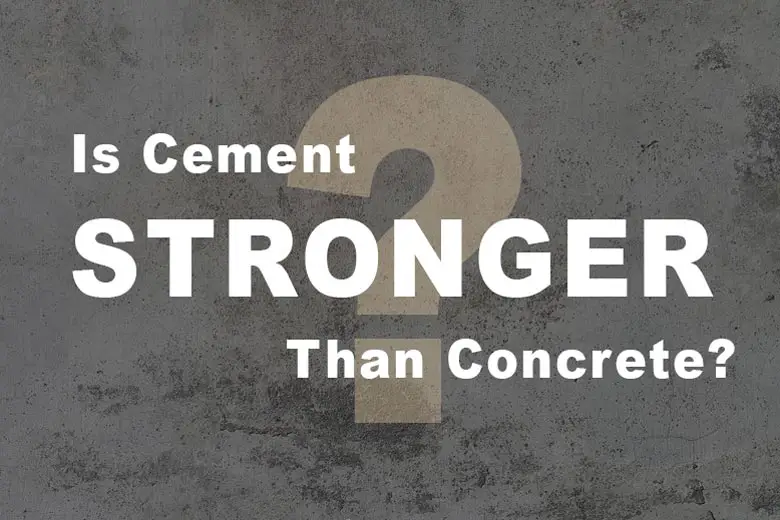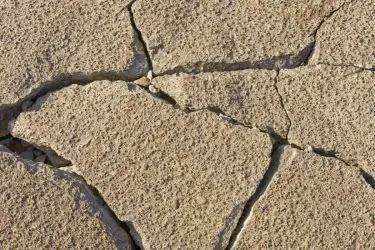Many people will be surprised to learn that cement and concrete, while similar, are not the same thing and differ in some very fundamental ways. This will naturally pose some obvious questions, such as what is the difference, what are they used for, and of course, which one is stronger?
Concrete is much stronger than cement. Cement is one ingredient of concrete, along with gravel, water, air, and sand. While cement is used for small jobs, such as fixing cracks and grouting tiles, concrete is used for the large-scale construction of things like roads, bridges, and sidewalks.
In this article, we will begin by providing some background information about concrete and cement, their uses, and what makes them different and unique from one another. We will also briefly discuss the method by which the strength of cement and concrete are rated. Finally, based on all of this context, we will be able to definitively state which of the two is stronger.

Table of Contents
What Is the Difference Between Cement and Concrete?
Among those who are relatively unfamiliar with concrete and cement, there seems to be a prevalent notion that the two words are synonymous or that these words define more or less the same thing, i.e., that hard stuff that the sidewalk is made from.
This is understandable because, as you will learn in a moment, there is a fundamental similarity between concrete and cement. Still, these words ultimately refer to two different and distinct materials.
The differences between concrete and cement are vast and encompass the ways they are made, the ways they’re used, and how they are rated for strength.
Cement: Overview
Cement is a human-made mixture of various material components.
The majority of cement’s mixture is made up of lime and silica, but alumina, magnesia, alkaline, iron oxide, calcium sulfate, and sulfur trioxide are also involved in its creation.
Cement can be purchased in powder form from most hardware stores. This needs to be mixed with water until the desired consistency is reached.
The production of cement is a surprisingly complex and intricate process that requires a lot of chemistry knowledge to perform properly.
What Is It Used For?
Cement is used as a primary ingredient in other compound mixtures, like concrete and mortar.
The other big thing that sets cement apart from concrete is the type of jobs they are used for.
Pure cement is used for more small-scale jobs like tiling, making repairs to floors and ceilings, and other jobs of this nature.
Cement is very adhesive once it settles, which is one of the things that make it ideal for repairing and binding. However, you would not use cement for something like making a curb or a ramp.
That being said, those who are in the concrete trade will also work with cement.
Think of cement as something of an accessory to concrete when in the context of the construction field. Concrete workers will always have some cement on hand for quick fixes and odd jobs.
Concrete: Overview
By now, we are beginning to get the idea of where the differences between concrete and cement lie. As mentioned above, cement is a key ingredient in concrete.
Set concrete consists of cement, water, air, gravel, and sand.
Concrete typically comes in powdered form. Once it is mixed with water, it begins to assume a smooth, mud-like consistency that must be constantly stirred from that point on: otherwise, it will begin to harden.
In many places, concrete and cement workers are officially considered trade workers because there is a high level of skill and expertise required for constructing structures with these materials.
Related Article: Concrete Worker Average Salary and Hourly Pay
Concrete work must be done with great care and precision because once it dries, hardens, and sets, there is no changing it. If you make a mistake, concrete can be very unforgiving.
If serious mistakes are made, the work may need to be demolished and redone, which is laborious, time-consuming, and expensive. This is why concrete workers are perfectionists by nature.
What Is It Used For?
Concrete is used for big jobs. This includes but is not limited to making concrete walkways, curbs, basement foundations, bridges, etc.
Concrete is a very important construction material and is often contained, transported, and poured from a specially designed concrete truck when the scale of the job calls for it.
How Is Cement and Concrete Strength Rated?
Because concrete is used in construction projects like the building of roadways and apartment buildings, strength standards must be regulated to meet certain building code requirements.
Since this is the case, there must be an objective way to measure its strength.
The strength of concrete is measured according to its PSI (pounds per square inch) of resistance against compressive force.
When you purchase bags of concrete mix from the store, the package will display the PSI strength.
4,000 PSI concrete, for example, is suitable for the building and construction of things like roads and basement foundations. 4,000 PSI would be at or around the minimum strength on the spectrum of acceptability.
The strength of cement is generally less important because it is used for much smaller jobs. With that being said, it is still important that cement be strong and reliable because it is, after all, one of the main ingredients in concrete.
Cement is measured against many different types of stressors, like sheer, compressive, and tensile force.
Which Is Stronger Concrete or Cement?
Concrete is stronger than cement because it is designed specifically to withstand a huge amount of force and maintain its strength and integrity, year after year. You cannot have concrete without cement as cement is an ingredient of concrete. In other words, without strong cement, you can not produce strong concrete.
The two things have a direct and close relation in that sense.
None of this is to say that cement is weak in any way, but concrete is the stronger and denser of the two. If you are planning on doing a job where strength and scale are factors, always use concrete.
If you find yourself about to embark on a job, such as building a concrete step or porch, and you’re not sure which concrete to use, a general-purpose mix from a reputable name brand is always the way to go.

The most reputable and consistent concrete product on the market is Quikrete’s fast-setting concrete mix, and for that reason, we highly recommend it for any job you happen to be doing.
Always wear the proper personal protective equipment when working with concrete. Wear a mask to protect yourself from the dust cloud that is given off when you begin pouring your concrete.
It is also important to wear safety glasses to protect your eyes from small stones and other airborne matter that may hurt or injure them. This safety goggle and respirator kit by BAOMAO brand is very affordable and will allow you to work safely.
Conclusion
The purpose of writing this article was twofold. First, we wanted to drive home the fact that concrete and cement are not the same things by explaining in detail the different ways how they are made and used; and second, to determine which of the two is stronger.
Concrete is made from cement, and as such, it is much stronger. Concrete is a mixture of sand, water, air, gravel, and cement and is designed for heavy-duty construction, like building roads.
Cement is used more for decorative and superficial work, like tile grouting, for instance.



